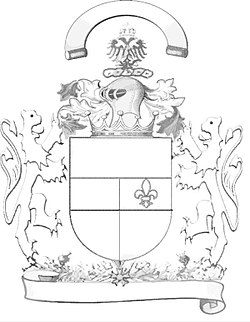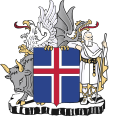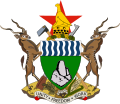Trzymacze heraldyczne
Trzymacze heraldyczne, nazywane również podporami tarczowymi[1] lub bocznicami[2] – postacie ludzkie lub zwierzęta umieszczane po jednej lub – częściej – po obu stronach, niekiedy za tarczą herbową, i podtrzymujące ją[1].
Opis
W charakterze trzymaczy mogły wystąpić w zmienionej nieco formie godła heraldyczne, postacie ludzkie – rycerze, Murzyni, giganci, aniołowie – zwierzęta rzeczywiste i fantastyczne – lwy, orły, gryfy, centaury i inne[1]. Trzymaczom często podkładano pod nogi lub łapy specjalny postument heraldyczny, jedynie ptaki – trzymacze wyglądały naturalnie unosząc się swobodnie.
 Lew |  Jednorożec |
Trzymacze są udostojnieniem herbu, nie mogły być stosowane dowolnie i samowolnie lecz jedynie na mocy specjalnego aktu nadania.
W polskiej heraldyce użycie trzymaczy nie zostało jak dotąd ujęte przepisami, stąd pojawiają się one dowolnie, jako ozdoba herbu. W okresie rozbiorów używanie trzymaczy herbowych zostało ograniczone przez heroldie państw zaborczych tylko do tych prawnie nadanych. Jednak nie wydaje się by była to regulacja wiążąca dla polskiego prawa i obyczaju heraldycznego. Znanym przykładem trzymaczy herbowych w Polsce są złote lwy z herbu Gdańska.
Trzymacze w herbach
Trzymacze w
herbie Wielkiej BrytaniiTrzymacze w
herbie KanadyTrzymacze w
herbie Nowej ZelandiiTrzymacze w
herbie ŁotwyCztery trzymacze w
herbie IslandiiTrzymacze – antylopy kudu w herbie Zimbabwe
Trzymacze w
herbie GdańskaTrzymacze w
herbie BawariiTrzymacze w
herbie BremyRośliny trzymacze w herbie stanu Rio Grande do Norte
Przykład trzymacza nie trzymającego tarczy w herbie książąt Devonshire
Trzymacze w herbie Baronessy Margaret Thatcher
Zobacz też
- Nosiciel
- Postument heraldyczny
Przypisy
- ↑ a b c Paweł Dudziński: Alfabet heraldyczny. Warszawa: Diogenes, 1997, s. 29. ISBN 83-7129-476-X.
- ↑ Niesiecki 1839 ↓, s. 478.
Bibliografia
- Kasper Niesiecki, Herbarz polski, Jan Nepomucen Bobrowicz, t. VII, Lipsk: Breitkopf i Haertel, 1841, s. 585.
Media użyte na tej stronie
Autor: Milenioscuro / Ssolbergj, Licencja: CC BY-SA 3.0
Supporters lions rampant
Coat of arms of Latvia.
Coat of arms of Iceland
Autor: Glasshouse, Licencja: CC BY-SA 4.0
Coat of Arms of the Free State of Bremen
Autor: Ta ^specifik^ z W3C grafika wektorowa została stworzona za pomocą Inkscape ., Licencja: CC BY-SA 3.0
Royal coat of arms of the United Kingdom of Great Britain and Northern Ireland as used by Queen Elizabeth II from 1953 to the present (as used in all her realms except Scotland). -----
| “ | Quarterly, First and Fourth Gules three lions passant guardant in pale Or armed and langued Azure (for England), Second quarter Or a lion rampant within a double tressure flory counter-flory Gules (for Scotland), Third quarter Azure a harp Or stringed Argent (for Ireland), the whole surrounded by the Garter; for a Crest, upon the Royal helm the imperial crown Proper, thereon a lion statant guardant Or imperially crowned Proper; Mantling Or and ermine; for Supporters, dexter a lion rampant guardant Or crowned as the Crest, sinister a unicorn Argent armed, crined and unguled Proper, gorged with a coronet Or composed of crosses patée and fleurs de lys a chain affixed thereto passing between the forelegs and reflexed over the back also Or; Motto 'Dieu et mon Droit' in the compartment below the shield, with the Union rose, shamrock and thistle engrafted on the same stem. | ” |
- PINCES, J.H & R.V., The Royal Heraldry of England, 1974, Heraldry Today.
Autor: Sodacan, Licencja: CC BY-SA 3.0
Coat of arms of Margaret Thatcher, The Baroness Thatcher (1925-2013), Prime Minister of the United Kingdom from 1979 to 1990. This achievement was used from 1995 to 2013, granted originally by the College of Arms in 1992 and was designed by the Garter King of Arms Sir Colin Cole. This version displays the circlet of the Order of the Garter to which she was appointed to only in 1995.
| “ | On a lozenge circumscribed by the Garter and the Ribbon of the Order of Merit with Cross pendant therefrom, surmounted by a baron's coronet, per chevron azure and gules, a double key in chief between two lions combatant a tower with portcullis in base all or, with supporters: dexter: An admiral of the British Navy; sinister: Sir Isaac Newton holding in his left hand weighing scales, both proper. Her motto was: "CHERISH FREEDOM" | ” |
Autor: Oryginał: Qyd
Praca pochodna: Steifer, Licencja: CC BY-SA 2.5
Elementy herbu.
Autor: Ta ^specifik^ z W3C grafika wektorowa została stworzona za pomocą Inkscape ., Licencja: CC BY-SA 3.0
Royal Coat of Arms of the United Kingdom of Great Britain and Northern Ireland as used by Queen Elizabeth II from 1953 to the present (as used in all her realms except Scotland). -----
| “ | Quarterly, First and Fourth Gules three lions passant guardant in pale Or armed and langued Azure (for England), Second quarter Or a lion rampant within a double tressure flory counter-flory Gules (for Scotland), Third quarter Azure a harp Or stringed Argent (for Ireland), the whole surrounded by the Garter; for a Crest, upon the Royal helm the imperial crown Proper, thereon a lion statant guardant Or imperially crowned Proper; Mantling Or and ermine; for Supporters, dexter a lion rampant guardant Or crowned as the Crest, sinister a unicorn Argent armed, crined and unguled Proper, gorged with a coronet Or composed of crosses patée and fleurs de lys a chain affixed thereto passing between the forelegs and reflexed over the back also Or; Motto 'Dieu et mon Droit' in the compartment below the shield, with the Union rose, shamrock and thistle engrafted on the same stem. | ” |
Autor: Sodacan, Licencja: CC BY-SA 3.0
Coat of Arms of New Zealand (1956-Present)
- The Coat of Arms depict a shield with four quadrants divided by a central "pale". The first quadrant depicts the four stars on the flag of New Zealand; the second quadrant depicts a golden fleece, representing the nation's farming industry; the third depicts a sheaf of wheat for agriculture; and the fourth quadrant depicts crossed hammers for mining. The central pale depicts three galleys, representing New Zealand's maritime nature and also the Cook Strait. The Dexter supporter is a European woman carrying the flag of New Zealand, while the Sinister supporter is a Maori Warrior holding a Taiaha (Fighting weapon) and wearing a Kaitaka (flax cloak). The Shield is topped by the Crown of St. Edward, the Monarch of New Zealand's Crown. Below is a scroll with "New Zealand" on it, behind which (constituting the "heraldic compartment" on which the supporters stand) are two fern branches.































